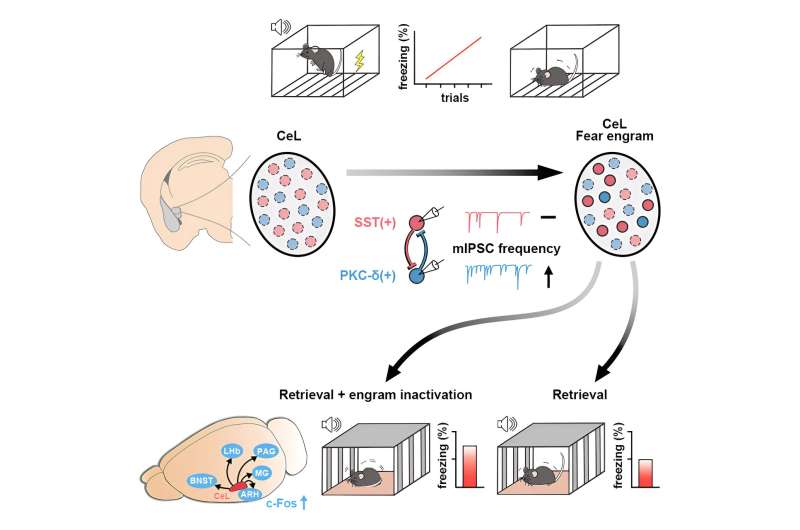This article has been reviewed according to Science X's editorial process and policies. Editors have highlighted the following attributes while ensuring the content's credibility:
fact-checked
peer-reviewed publication
proofread
Mouse study illuminates how fearful memories form

A newly discovered mechanism of fear memory formation in mouse brains may help reduce the negative impact of fear and provide new treatment methods for post-traumatic stress disorder (PTSD) in the future , according to a study published on August 5th in the open-access journal Cell Reports by Wen-Hsien Hou from National Yang Ming Chiao Tung University, Taiwan, and colleagues.
Recent literature has indicated that a group of nerve cells in the central amygdala regulates fear emotions. However, it was previously unclear whether specific nerve cells in this area are involved in forming fear memories and regulating responses to recalling these experiences.
Most neuroscientists study how excitatory nerve cells in the brain handle memory storage and response, but they lack an understanding of the role of inhibitory nerve cells. This gap in knowledge makes it difficult to reveal how fear memories are regulated and how the brain reacts to them, such as maintaining an excitatory-inhibitory balance during the formation and recall of memories.
In this study, researchers used mice as a model. They applied fear memory and learning tests to observe mice behavior before, during and after fear conditioning experiments, which paired a harmless sound with a slight electric shock to the foot.
The study found that fear experiences activate a small group of inhibitory nerve cells in a specific brain region (the amygdala) in mice, preventing excessive reactions to fear memories.
Using genetically modified mice, researchers marked these nerve cells activated by different fear experiences (mainly somatostatin-expressing nerve cells). Inhibiting these marked nerve cells resulted in the mice exhibiting more fear.
"When these specific nerve cells were inhibited, the mice froze for a longer time when they anticipated an electric shock." explained Dr. Hou, the first author and currently an Assistant Professor at Aarhus University.
"These cells act like brakes, preventing excessive reactions to fear." said Prof. Cheng-Chang Lien who led the study.
This study enhances our understanding of the neural basis of fear memory formation and may offer potential solutions for treating PTSD.
The study has limitations. Although the brain structures of mice and humans are similar, there are differences in their neural circuits and connections. Further research is needed to determine if the central amygdala neurons regulate fear memories and responses in PTSD patients.
Additionally, using advanced techniques like gene editing and chemogenetics in humans poses significant challenges for clinical development.
More information: Wen-Hsien Hou et al, Inhibitory fear memory engram in the mouse central lateral amygdala, Cell Reports (2024). DOI: 10.1016/j.celrep.2024.114468

















